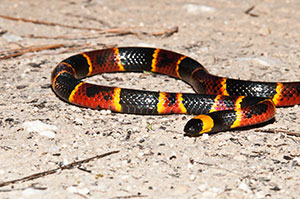Cottonmouth
Also known as the water moccasin, cottonmouths are a type of pit viper found mostly in the Southeastern United States. They are the only semiaquatic viper species in the entire world, and they can typically be found in or around shallow lakes, streams, and marshes. Though cottonmouths do prefer freshwater environments, they have been spotted in the ocean and are considered to be extremely strong swimmers. Cottonmouths are relatively plain in appearance, usually almost entirely black or in varying shades of brown, tan, or olive, and are thick-bodied snakes that can reach lengths of up to six feet. Notoriously aggressive, adult cottonmouths are capable of inflicting bites that are extremely painful and potentially fatal.
Diamondback Rattlesnake
Diamondbacks are another type of venomous pit viper commonly found in the Southeastern United States. They are the largest type of rattlesnake in North America and the biggest of all venomous snakes, though only in mass, not in length, though they can reach over eight feet long. Diamondback rattlesnakes can be found near water at times and are excellent swimmers, but prefer forests, woodlands, and areas of wet prairie during dry periods. They have also been known to live underground at times, utilizing former burrows of gophers and gopher tortoises. Although diamondbacks can deliver fatal bites, they are not typically aggressive and will usually warn anyone who comes too close to them by rattling their anteriors.
Dusky Pygmy Rattlesnake
Also commonly known as the Florida ground rattlesnake, dusky pygmy rattlesnakes are much smaller than diamondbacks, and often do not exceed two or three feet in length. This species can, however, be quite beautiful in appearance, with a series of black or brown round dorsal spots across their backs, and with whitish, flecked bellies. These small snakes can be feisty and quick to bite, and unlike their diamondback cousins, rarely give out any warnings by shaking their rattles. Fortunately, their fangs are small and deliver relatively low doses of venom with each bite, so while their bites are said to be severely painful, they very rarely are fatal, though small children and pets are at a greater risk.
Coral Snake
Don’t let their good looks fool you, because these beautiful and colorful snakes certainly pack a mean punch. Noted for their red, yellow, and black banded coloring, coral snakes can be particularly dangerous because they so closely resemble other non-venomous species of snake with banded patterns, such as the milk snake and the scarlet snake. Coral snakes are quite elusive and prefer to spend the majority of their time below ground or hiding beneath foliage. They are very shy and will always prefer flight over fight, and although they have one of the most potent venoms of all North American snakes, they account for less than 1% of all snake bites that occur each year. Unlike other venomous snakes, the bite of a coral snake is reportedly not very painful, but can cause death within a few short hours.
To observe these fascinating creatures in their natural environment and from a safe distance, head out into the Everglades on an airboat ride with Captain Mitch. Everglades tours are not only exciting for the whole family, but give you the perfect opportunity to safely view dangerous animals that you might not want to encounter otherwise.







